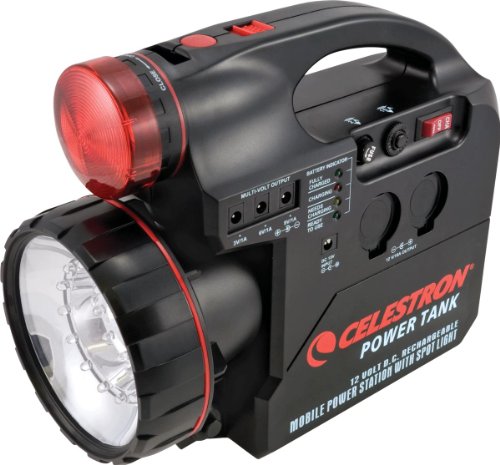Power Tank features the following: 7-amp hour Two 12V output cigarette lighter ports 3V,6V and 9V outputs for accessories Built-in flashlight with red filter cap 800,000 candle power Halogen emergency spotlight Booster terminal on rear side Built-in Circuit Breaker for safety Cigarette lighter adapter included AC adapter included
Product Features
- 7-amp hour portable rechargeable power supply for Celestron telescopes
- Two 12-volt output cigarette lighter ports
- 3, 6, and 9-Volt outputs for accessories
- Built-in flash light with red filter cap
- 800,000 Candle power halogen emergency spotlight






Essential gadget for large electronic Telescopes I used my Power Tank (17Amp version) for a whole year. After many months of bad weather, I stored it away with my Telescope. Six months of unattended storage were enough to kill the battery. I should had read the manual before putting it away for so long. These tanks need to be recharged at least once a month in order to preserve the cell inside. These power tanks contain a sealed dry 12Volt battery cell inside. One can probably replace it, but it in my case, the cost for the 17amp version is roughly $40 plus the risk of installation. I decided to get a new Power Tank 7Amp version because it is more than enough for my Telescope (Meade LX200GPS). In conclusion, the power tank is a must have for large 12Vdc telescopes, but one must take very good care of charging it at least once a month in order to get maximum lifetime of the product.
Charger hard to repair I have a 7 Ah unit and have been using it for years. Not bad for what it is — after all, deep down it’s just a 12V lead-acid battery. But one fine day it just stopped charging. At first I thought the battery was dead and so I went to Radio Shack and bought a new one for $15. It isn’t hard to replace and all the lights lit up and everything, but still no charging. Then I did what I should have done in the first place — measured the output voltage of the 15V power adapter. No voltage to speak of. Then I tried to repair the adapter itself but it turned out that one needs a screwdriver with a triangular tip to open the protective cover of this thing!! No hardware store in my area (and I checked quite a few) had such an outlandish screwdriver. For that matter, I couldn’t find a replacement either. It is hard to find a 15V adapter; most power supplies out there are 6, 9, or 12 volts. In summary, I’m left with a functional main unit and no easy way to charge it up. So, buyer beware: if something stops working you may well have to buy a brand new one.
Decent power for field use This battery unit has been usefull to me in the field as long as I don’t use a dew zapper for too long (more that 4 hours).
Comments are disabled for this post.